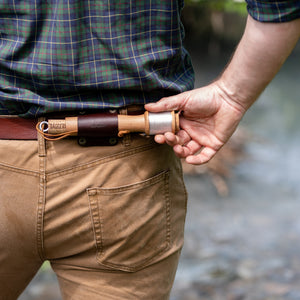4. Reeling a Handline and Setting the Hook
View Daggerfish Handlines and Accessories here.
Once you've learned how to cast a handline, you'll need to know how to reel it back in. This article covers reeling and hook setting using a handline.
NOTE: The video above covers these methods in detail and is highly recommended.
Reeling a Handline
A handline has no moving parts or mechanical components, so reeling is done entirely by hand. While many novice handliners are concerned about the line hurting your hand while reeling in, reeling with proper technique is completely safe. Here's how to do it:
Hold your handline in one hand and pinch the line gently between the fingers of your other hand. (Going forward, we'll refer to the hand holding the reel as your reel hand and the hand holding the line as your line hand.)

Keeping your line hand steady, begin rotating your reel hand at the wrist; clockwise for right-handed, counterclockwise for left-handed. Use the line hand to keep light tension on the line and guide it onto the reel. Increase or decrease the speed at which you rotate your reel hand based on how quickly you want to reel in your lure.
Tips:
- Position your reel hand with your fingers just below the reel. This will help prevent line from winding onto the handle below the reel, making casting easier.
- Experiment with which hand is the line hand and which is the reel hand. It's completely fine to switch your reel hand after casting if it's more comfortable for you.
- Do not attempt to pull a fish in using your line hand. It is safer and more effective to use the rotation of your reel hand, which creates leverage useful for fighting a fish.
- If pursuing larger fish (8 lbs or more), a light fingerless glove can be used on your line hand for added protection.
- Try to minimize slack in your line, and keep your line hand on the line even when not actively reeling. You can often feel fish bites through your line hand, even if you can't see a strike indicator.
Setting the Hook
When you feel a fish bite or see your strike indicator move, you'll need to set the hook and start reeling in your fish. To set the hook, draw your reel hand back sharply, or strip down your line with your line hand in order to quickly take up slack and set your hook.
If there is considerable slack in your line, do both at once to take up the slack, then reel quickly to recover your line tension to keep the fish on.
Keep your reel perpendicular to the direction of the line. This maintains tension on the line, especially when reeling in a fish. If it's necessary to let a fish run, you can turn your reel parallel to the line and allow line to spool off through your line hand, before turning the reel perpendicular again to start reeling.
Now that you know how to set up a handline for bait fishing or handline-style fly fishing, how to cast a handline, and how to reel in a fish, you're ready for a day of hand line fishing! Once you're finished, check out our guide to storing tackle at the end of the day.


























